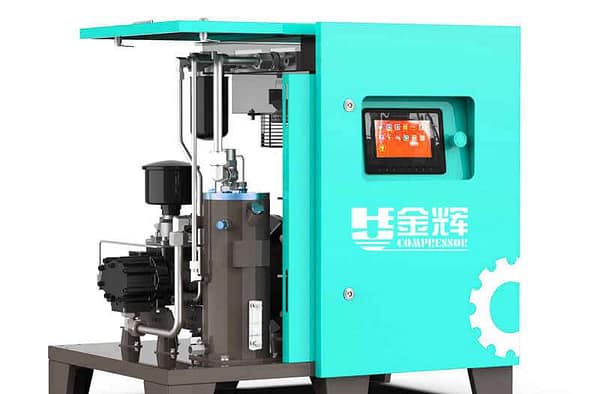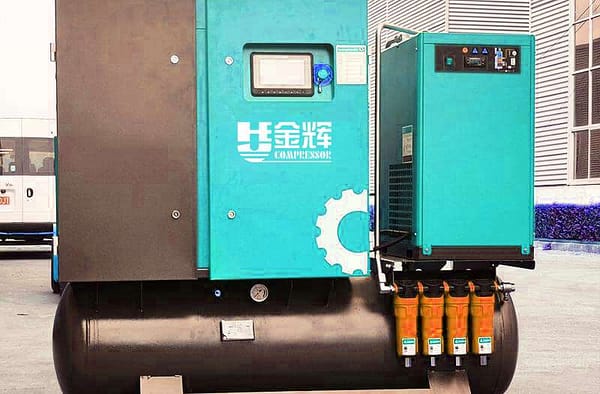
Air compressor maintenance core considerations: the key to prolonging life and ensuring safety
As the core power source of industrial production, the stable operation of air compressor is directly related to production efficiency and cost. Neglecting maintenance will not only significantly shorten the life of the equipment, increase energy consumption and maintenance costs, but may also lead to unexpected downtime, resulting in significant losses.Preventive maintenance is far better than repair after a breakdown. Here are the core things you must focus on in air compressor maintenance:
I. Core principles and knowledge of maintenance
-
Prevention is the mainstay and is implemented on a regular basis: Maintenance is centered on "preventing problems before they occur". Strictly follow the manufacturer's recommended maintenance intervals (based on hours of operation or time of day) and perform planned maintenance to prevent minor problems from becoming major breakdowns.
-
Records are golden: establish andtrack recordThe items, time, consumables replaced (brand and model), problems found and measures taken to deal with each maintenance. This is the basis for tracking cycles, analyzing failures, and optimizing maintenance schedules.
-
Safety first: Always before any maintenance operation:
-
Shutdown and power outage! Disconnect the mains and lock and tag (LOTO) to ensure complete isolation of energy.
-
Relief pressure! Drain all compressed air and condensate from the mainframe, piping, and tanks to verify that the system pressure drops to zero.
-
Allow the unit to cool and then operate the hot parts.
-
-
Professionalism and Normality: Critical maintenance (e.g., lubricant change, filter cartridges, valve servicing, mainframe maintenance) should be performed by trained professionals using specified tools and original/certified consumables. Strictly follow the equipment Operation and Maintenance Manual.
-
Environmental Adaptation: Depending on the actual operating environment of the air compressor (dust, humidity, temperature, continuous operation time)Adjustment of maintenance frequency. Harsh environments require shorter maintenance intervals.
II. Key Maintenance Items and Precautions
(i) Daily inspection and maintenance (performed by operators)
-
Operational parameter monitoring:
-
Content: Daily record or monitor exhaust pressure, exhaust temperature, oil pressure (if available), oil temperature, operating current/voltage, and hours of operation. Observe the control panel for alarm messages.
-
Attention: Abnormal fluctuations in parameters are often a precursor to failure and need to be investigated in a timely manner.
-
-
Oil level check (oil lubricated models):
-
Timing: After stopping the machine, wait for the oil temperature to drop close to the ambient temperature (oil reflux is complete).
-
Criteria: Ensure that the oil level is within the calibration range (Min~Max) by checking with an oil mirror or dipstick.
-
Attention: Oil level too low(Insufficient lubrication → high temperature wear)Oil level too high(Increased fuel consumption, heavy oil/air separation burden, risk of carbon buildup).
-
-
Condensate discharge:
-
Location: Air storage tank, aftercooler, dryer (if any), air/water separator (oil/water separator), filter drain cup.
-
Frequency: At least once a dayIf the environment is humid or continuous operation, the frequency needs to be increased.
-
Attention: Check that the automatic drain valve is working properly. Manual drain valves need to be drained thoroughly.Standing water can lead to rust, emulsified lubricants, and damage to back-end equipment.
-
-
Appearance and leakage check:
-
Content: Equipment surfaces are clean (no oil or dust buildup); check for leaks (oil stains, water stains, sound of air leaks) in the oil, air, and cooling systems (hoses/radiators); listen for unusual noises or vibrations.
-
Attention: Keep the equipment and the surrounding environment clean and well ventilated to dissipate heat.
-
-
Air filter cosmetic inspection:
-
Content: Visually inspect the air filter housing for dust accumulation. In dusty environments, carefully remove the housing and use low-pressure air (<0.3 MPa)from the inside outBlow out dust on the surface of the filter element (Temporary cleaning only, not a substitute for replacement!).
-
Attention: Prevent dust from entering the intake piping during operation.
-
(ii) Regular maintenance items (as per manual cycle, requires specialized or trained personnel)
-
Lubrication oil change (oil lubricated models - one of the most central items):
-
Cycle: Strictly according to the manual (usually 500 hours for the first time, 2000-8000 hours thereafter). High temperature, dusty, humid, continuous operation environmentMust be shortenedCycle.
-
Operation:
-
after shutdown and pressure reliefHeat the oil while it's hot.(Good fluidity and more thorough drainage of impurities).
-
sweepOld oil, clean oil pan (if possible).
-
change (one's address etc)oil filterThe
-
become a memberDesignation of grades and gradesof new oil to the specified level.
-
record (in sports etc)Change time, oil brand number, and quantity.
-
-
Attention: Poor quality oil, mixed oils, and overuse are common causes of damage to the mainframe.
-
-
Replacement of the "three filters" (air filter, oil filter, oil/air separator):
-
Air Filter:
-
Cycle: Usually 1500-3000 hours or differential pressure indicator alarm. Dusty environmentsshorten significantlyThe
-
Attention: Clogging leads to insufficient air intake, soaring energy consumption, and high-temperature wear and tear of the main unit. Replacement is strictly to prevent the entry of dust.
-
-
Oil Filter:
-
Cycle: Usually synchronized with an oil change or per manual (e.g. 2000 hours).
-
Role: Protects main engine bearings and rotors from metal chips and sludge.
-
-
Oil-air separator (oil separator):
-
Cycle: Usually 3000-8000 hours or differential pressure indicator alarm/abnormal increase in fuel consumption.
-
Role: Ensure low oil content in exhaust gas and recover lubricating oil. Failure to do so leads to a dramatic increase in oil consumption, contamination of the back end, and affects product quality.
-
Attention: When replacing ensure that the seals are installed correctly to prevent short circuiting.
-
-
-
Cooling system clean:
-
Air-cooled models:
-
Content: Clean the cooler fins (heat sinks) of dust, oil, willow, etc. Check the condition of the cooling fan.
-
Cycle: Quarterly or depending on dirty blockage (high temperature alarm precursor).
-
Attention: Use compressed air or a soft brush to avoid damaging the fins.Poor heat dissipation is the main cause of high temperature shutdowns.
-
-
Water-cooled models:
-
Content: Check the quality of cooling water (hardness, PH, impurities) and carry out water treatment or water exchange as required; clean the scale in the water cooler regularly (e.g. annually).
-
Attention: Scale seriously affects heat transfer efficiency.
-
-
-
Electrical and safety device inspections:
-
Content: Check electrical wiring tightness; check contactor contacts (corrosion, wear); test safety valve trip pressure (manually pulling up on the test ring should vent the air and reset when released); calibrate/check pressure and temperature sensors.
-
Cycle: By manual (usually six months or one year).
-
Attention: Safety valves are the last line of defense for pressure vessels.Clogging or adjustment is strictly prohibited! Periodic calibration is required.
-
-
Gas storage tanks and piping:
-
Regular sewage discharge: (soup etc) of the dayDrain condensate (routine maintenance) and make sure the drain valve is closed tightly.
-
Attention: (b) long-term accumulation of water leading to rusting and perforation of the tank.Serious safety hazard!
-
Statutory Annual Inspection: Pressure vessels (gas storage tanks)necessarilyPeriodic external inspections (usually 1 year) and internal inspections (usually 3-6 years) are carried out in accordance with national regulations and are performed by qualified organizations.
-
(iii) Use of the environment and operating norms
-
Supply Voltage:
-
Request: The input power supply voltage must be the same as that indicated on the compressor's nameplate.Rated voltage matchesThe fluctuation range is usually within ±5%.
-
Hazards: input voltageexorbitant: Burning of motors, electrical components, risk of serious personal accidents. Voltagetoo low: Difficulty in starting (sharp increase in current), motor overheating and burning, lack of output.
-
-
Installation environment:
-
Temperature: Keep well ventilated. Ideal air intake/ambient temperature 5-40°CThecrystal growthThe environment can dramatically reduce efficiency, increase power consumption, accelerate oil aging, and shorten life;low temperaturesStart-up requires preheating of the lubricant (if this feature is available).
-
Humidity and dust: Avoidance ofexcessive humidity(increased corrosion, lubricant emulsification) orDusty, flammable, explosive, corrosive gases/vaporsThe following are some examples of the types of places in which this product can be operated. If installation in such environments is necessary, special protective models and enhanced ventilation/filtration are required.
-
Space: Reserve enough space for maintenance (front, back, left, right and top) to ensure unobstructed air intake and exhaust.
-
-
Standardize operations:
-
Start and stop the equipment in strict accordance with the operating procedures.
-
Avoid frequent starting and stopping or prolonged overloading.
-
When the machine is not in use (especially when it is out of use for a long period of time), make sure to empty the air and condensate in the system, take good measures to prevent rust, and store it in a dry environment.
-
III. Implementing the recommendations: putting maintenance into practice
-
Establishment of systems: Develop a written Air Compressor Maintenance Procedure that specifies the content, standard, cycle, and responsible person for each job.
-
Trainers: Adequate training for operators and maintenance personnel in equipment operation, routine inspection and basic maintenance, emphasizing safety awareness.
-
Equipped with resources: Prepare necessary tools, spare parts (common cartridges, oils) and record forms.
-
Utilization of technology: Consider a networked equipment monitoring system to track operating parameters in real time for predictive maintenance.
-
Professional support: Establish links with reliable suppliers or service providers to ensure specialized maintenance and overhaul capabilities.





